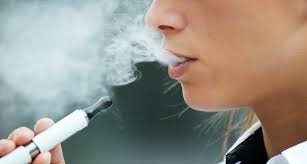Vaping
The usage of Electronic cigarettes is growing in popularity. Unfortunately, this includes use children and teens. In 2016, more than 2 million U.S. middle and high school students used e-cigarettes in the past 30 days, including 4.3% of middle school students and 11.3% of high school students.
These products come in stylish packages that are attractive to young people and adults. E-Cigarettes come in fruit, candy and dessert flavors that are particularly appealing to children. One vaporizer looks like a USB flash drive and fits in the palm of the hand (see picture below). Others look like flashlights or pens. Teens are posting pictures of themselves using these products on social media while at school and other social engagements.

The Truth about Electronic Cigarettes
- These devices are NOT safe alternatives to smoking. Vaping is advertised as being healthier and safer than cigarettes and that they help people stop smoking. Research has not proven these claims and the products contain chemicals that are known to cause cancer.
- Children can be exposed to these toxins in the environment through second- and third-hand smoke. Thirdhand smoke is when the substance remains on surfaces and in dust after use and is released into the air at a later time.
- The substances in the liquid are toxic when the non-vaporized liquid is absorbed through the mucous membrane of the mouth, when ingested or when spilled on skin. Poison control centers reported 3,000 children were exposed, some hospitalized and at least 1 death. Parents of children under the age of 5 should store these substances out of reach of children. Symptoms of nicotine poisoning include:
- Vomiting
- Sweating
- Dizziness
- Increased heart rate
- Lethargy
- Seizures
- Difficulty breathing
- These products are technically called Electronic Nicotine Delivery Systems. There are a variety of names used for electronic cigarettes, including but not limited to:
- E-Cigarettes
- E-Cigs
- Electronic Cigars,
- Electronic hookah, e-hookah, hookah sticks
- Personal vaporizers
- Mechanical mods
- Vape pens
- Vaping device
- E-cigarettes are not as regulated as strongly as tobacco products, so labeling is not consistent and may not provide accurate information about the nicotine amount and other harmful ingredients.
- These products are being marketed to your children and are readily available.
- Injuries have occurred when the devices have exploded during use and spontaneously.
- Nicotine negatively affects brain development in children and teens. Nicotine is a “gateway” drug to the use of illicit drugs.
- These devices are being used to “vape” substances other than nicotine liquids, including marijuana.

Tips for parents
- Educate yourself on E-Cigarettes, for your own health, as well as your child’s. Get help quitting if you use these products.
- Educate your child about the dangers and role play with him/her how to respond when offered these substances.
- Have regular conversations with your middle and high school children about the reality of what they are seeing.
- Keep the phone number for poison control programmed in your phone in the event of any accidental exposure.
- Do not use while pregnant or trying to get pregnant.
Other resources to support your education
Talk with Your Teen about E-Cigarettes: A Tip Sheet for Parents
Facts for Parents about E-Cigarettes & Electronic Nicotine Delivery Systems
Liquid Nicotine Used in E-Cigarettes can Kill Children
E-cigarettes: Dangerous, Available & Addicting







